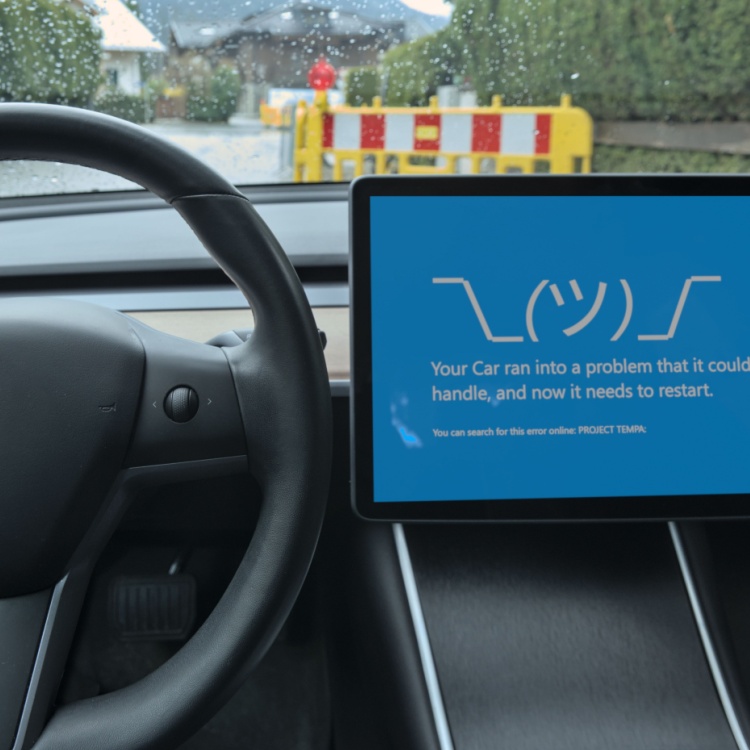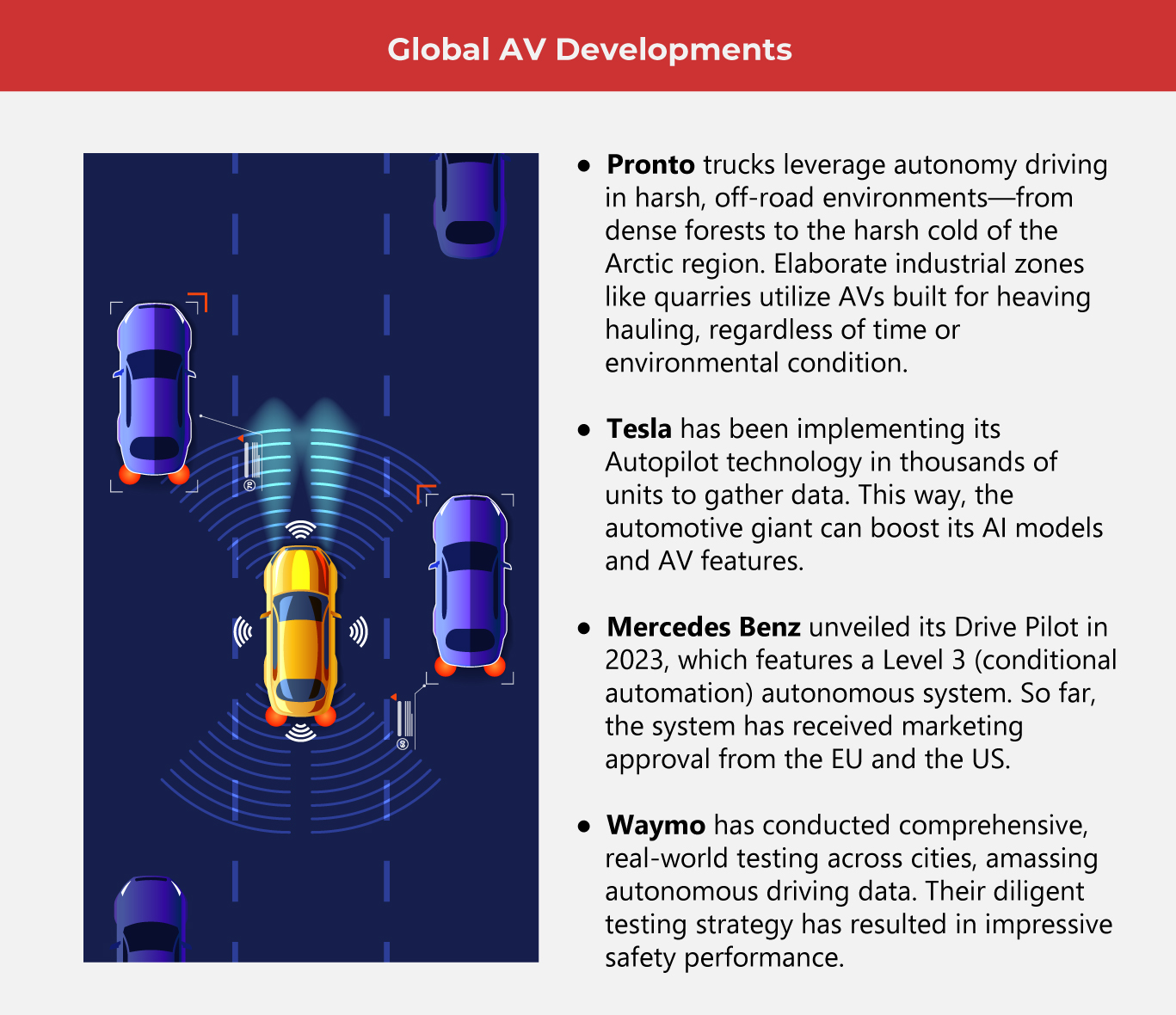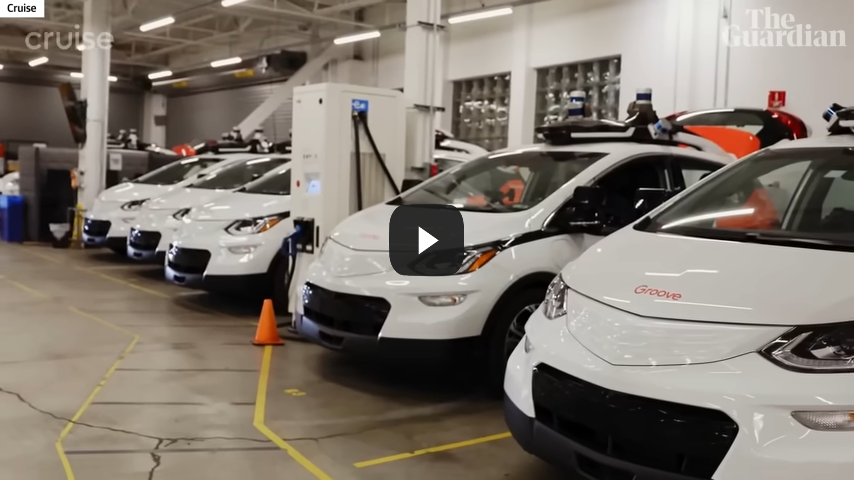Top 8 Challenges for the AV Industry

Autonomous vehicles (AVs) face speedbumps that curtail their growth and full potential. Learn the hurdles the AV industry needs to overcome, especially in issues concerning road safety, data processing, and legalities.
The autonomous vehicle (AV) industry has the power to transform transportation, boosting mobility and motorist safety. Because of its promising benefits, experts predict its market to grow to US$2 trillion in 2030.
However, earlier projections, as far back as 2016, stated that millions of self-driving cars would be on the road by 2020. Fast-forward to 2024, and this prediction seems far from happening. Learn the reasons behind the stalled adoption of AVs.
Top 8 challenges for AV companies in 2024
1. Safety
This is a priority for emerging technologies, particularly those that eliminate human involvement. Driving is so complicated, so AV companies should ensure their systems' reliability in various road situations. In the miles per critical intervention (MPCI) method, a human safety driver takes control when the AV faces unclear situations. The company then simulates the human driver's response to avoid accidents.
2. Legalities
Countries have different AV regulations, making it challenging for companies to mobilize AVs globally. While Japan allows Level 4 (fully autonomous) AVs to manage risky situations without human involvement, the US has varying measures per state. Meanwhile, the Chinese government is pushing for AV's swift development amidst liberal guidelines. In Germany and most of the EU, robust frameworks are being developed to boost AV safety and advancement.
3. Ethics
AVs should be able to make quick decisions like a human driver. This raises ethical dilemmas with self-driving vehicles, such as prioritizing between passenger safety and pedestrians. Should AVs make decisions based on the collective good over individual safety? Who should be held accountable when AVs malfunction—the company or software developer? All these questions have no straightforward answers. Additionally, answers may vary depending on the government.
4. Infrastructure
Substantial capital and infrastructure investments are needed to scale AV’s progress from test models to large-scale production. Adjusting existing road systems originally planned for human drivers to accommodate AVs is no small feat. Dedicated lanes for self-driving vehicles, data storage facilities, and enhanced charging systems are examples of necessary infrastructure.
5. Consumer hesitancy
Autonomous driving is still unpopular mainly because of the possible job displacement in the transportation field and misgivings about assigning the driving task and human safety to a machine. Moreover, widely-publicized accidents that include AVs have resulted in increased skepticism. Another hurdle is the willingness of humans to adopt the technology. Given our inherent resistance to change, giving up the habit of driving the vehicles ourselves may be difficult.
6. Data management
To prepare AVs for mass production, the industry must process, store, and analyze copious amounts of data in real time. Data from sensor systems involving cameras, lidars, radars and GPS powers autonomous driving. Because the industry heavily relies on data, potential consumers are worried about cyberattacks that endanger personal security and privacy.
7. Moving the conversation away from personal vehicles
Admit it; the first thing you thought of when you first heard about AVs is how nice it would be to let your car drive itself as you catch up with social media on your way to work. However, an influx of personal AVs on the road would only lead to traffic buildup. A smarter way of initially using AVs is for freight, transporting goods around the clock. Only a handful of humans can oversee the operations inside a closed-off area to ensure safety. Such a simple setup enables the technology to be constantly observed and enhanced, paving the way for innovation.
8. Law enforcement
While AVs offer numerous benefits, they can be potentially used for criminal activities, like transporting illegal goods. Will traffic enforcers have special rules for AVs? To remedy this, officers need training that caters to AV operations. Governments must enforce laws and regulations, including standards for managing road incidents and accidents involving AVs.
Finding solutions for AV challenges
While adopting AV technology poses several obstacles, these can be resolved in many ways.
-
Optimizing technology
Technology is constantly evolving, and companies must leverage its improvements. By mixing technologies such as sensory networks and artificial intelligence (AI), AVs can better interpret their surroundings, leading to boosted decision-making. Meanwhile, tech-driven infrastructure can further enhance the use of AVs. For instance, smart traffic lights can identify incoming pedestrians and alert self-driving vehicles.
-
Standard regulations
Universal safety protocols and regulations can steer manufacturers in the right direction, improving public perception of AV safety while facilitating effective infrastructure development. Moreover, standard regulation allows interoperability among different manufacturers and AV networks. With uniform communication rules, data formats, and contact points, the AV industry can easily collaborate and advance its technologies.
-
Strong collaboration
A consolidated approach can help AV companies find solutions for most of their issues. Partnering with the insurance industry can help them handle risk and liability. Ethics and legal issues are resolved by collaborating with ethics experts, policymakers and the public. While AV infrastructure is a complex endeavor, infrastructure improvements are easier to accomplish by teaming up with the automotive industry, innovation companies, and governments.
-
Transparency
Transparency, active involvement, and information campaigns are essential in encouraging the acceptance and adoption of AVs. While demonstrating the advantages of the technology, companies should also disclose all their reports and incidents while testing prototypes. As governments craft robust regulations for gradual deployment, the industry must also address the argument on job displacement. Companies can better convince the public about the AV market's potential with an empathy-driven communication strategy.
-
Cybersecurity
Cyberattacks are a constant threat to digital data. To assure consumers, companies should highlight cybersecurity features and invest in sophisticated encryption, regular security improvements, threat vigilance and penetration tests. By formulating best practices on AV cybersecurity, companies stay committed to securing confidential data.
Automation clearly has the potential to revolutionize the automotive industry, but it first needs to overcome its major setbacks. The solution lies in solid partnership and transparency so stakeholders can ensure that the technology aligns with society's needs.

As one of the Top 20 EMS companies in the world, IMI has over 40 years of experience in providing electronics manufacturing and technology solutions.
We are ready to support your business on a global scale.
Our proven technical expertise, worldwide reach, and vast experience in high-growth and emerging markets make us the ideal global manufacturing solutions partner.
Let's work together to build our future today.
Other Blog


